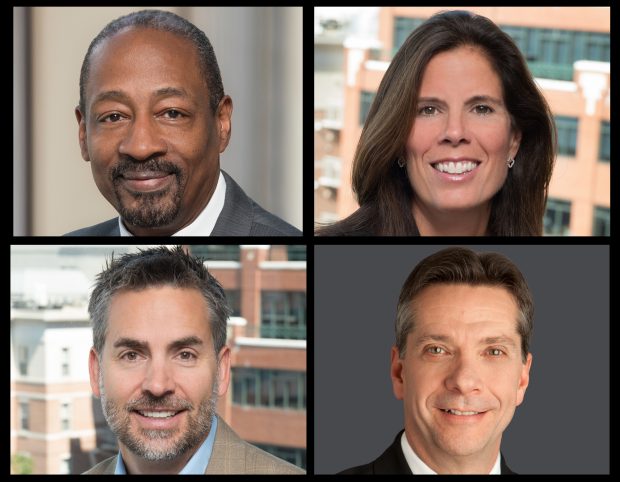 Clockwise, from top left: EVP Jeffery R. Hayward, heads up of Fannie Mae Multifamily, leading a team that includes Michele M. Evans, SVP and Chief Operating Officer; Rob Levin, SVP and Head, Customer Engagement; and Manuel Menendez, Jr. , SVP and Multifamily Chief Credit Officer.
Clockwise, from top left: EVP Jeffery R. Hayward, heads up of Fannie Mae Multifamily, leading a team that includes Michele M. Evans, SVP and Chief Operating Officer; Rob Levin, SVP and Head, Customer Engagement; and Manuel Menendez, Jr. , SVP and Multifamily Chief Credit Officer.
Earlier this year Fannie Mae completed a transaction in which seven reinsurers and insurers took on about $166 million of multifamily credit risk on a pool of debt that totaled around $11.1 billion. The transaction, a credit insurance risk transfer, was the first time Fannie Mae widely marketed these assets to reinsurers and was pleasantly surprised to find the deal oversubscribed.
It shouldn't have been. For years Fannie Mae, as well as its counterpart Freddie Mac, have been expanding and tweaking their investment product lines to make them more attractive to a broader array of investors. Fannie Mae, in particular, has gotten quite good at that, introducing a number of innovations that have appealed to investors outside of Fannie Mae's usual audience in 2018 alone. For instance, it made a change to its benchmark Connecticut Avenue Securities structure so they would better suit mortgage REITs' portfolios. Briefly, Fannie Mae is now structuring CAS offerings as notes issued by trusts that qualify as Real Estate Mortgage Investment Conduits.
In another move, a Fannie Mae Multifamily Green GeMS REMIC has been added to Bloomberg Barclays MSCI Green Bond Index, opening the door for a more diverse investor base and improving its liquidity to boot.
Multifamily borrowers—alongside the investors—have also benefited from the GSE's innovation spree. At the start of the year Fannie Mae added a new product to its Healthy Housing Rewards initiative called Enhanced Resident Services. Its goal is to encourage multifamily borrowers to provide services that improve the health and well-being of tenants in affordable housing. Examples include health and wellness screening, connecting residents with government health benefits, after-school programs, on-site food banks, financial literacy classes and job training or GED programs.
Fannie Mae has been lauded for other green initiatives—indeed its overall green finance programs are seen as a trendsetter in the field. It earned the 2018 ENERGY STAR Partner of the Year Award for Sustained Excellence, for example. Also, the Climate Bonds Initiative recognized Fannie Mae as the largest issuer of green bonds in the world last year, when Fannie Mae issued $27.6 billion in green mortgage-backed securities that were backed by either green building certified properties or properties targeting a reduction in energy or water consumption. This was up from $3.6 billion in 2016 and $111 million in 2015. With its award, Fannie Mae became part of a community of “organizations and individuals who are amongst the new leaders of global finance, creating new markets and mobilizing the green capital urgently needed to address climate change,” according to Climate Bonds' CEO, Sean Kidney.
From January through August 2018, Fannie provided $37.3 billion in financing to support multifamily housing. It's a telling number, as last year neither Fannie nor Freddie used the 2017 multifamily lending caps of $36.5 billion that the Federal Housing Finance Agency set for the GSEs. It was a significant development since it not only indicated that the uncapped businesses by the GSEs flourished, but also suggested that the reduced cap of $35 billion each that the FHFA set for 2018 shouldn't hamper the multifamily finance market.
Not reaching their cap for 2017 also pointed to prudent lending on the part of the GSEs—even as they have stretched their programs to accommodate more collateral types and new structures.
Certainly, prudent lending is part of Fannie Mae's M.O. The GSE differs from its counterpart in that it uses a Delegated Underwriting and Servicing model; in fact, this is the 30th anniversary of the GSE's DUS program. The program is executed primarily through its DUS lender network of 25 financial institutions and independent mortgage lenders, which typically assume one-third of the risk of the loans—one of the hallmarks of DUS, Fannie Mae says. The GSE will finance loans of all sizes, from a $1-million single-asset loan to a $1 billion structured transaction.
Jeffery R. Hayward is EVP and head of Fannie Mae Multifamily, responsible for all business functions. In addition to overseeing the division's day-to-day operations, SVP and multifamily COO Michele M. Evans handles business transformation, strategy, product development and management, securitization and the firm's Multifamily Target State technology initiative. As head of customer engagement, SVP Rob Levin leads Fannie's multifamily production activities, including the DUS platform, structured transactions, seniors and affordable housing, green financing, small loans and borrower relationships. Rounding out the main leadership team is Manny Menendez, SVP and multifamily chief credit officer, who is responsible for establishing the strategic framework to analyze, manage and mitigate credit risk for the multifamily unit's mortgage business. He also oversees credit and underwriting standards.
Return to Main List
Continue to Next Influencer . . .
© 2025 ALM Global, LLC, All Rights Reserved. Request academic re-use from www.copyright.com. All other uses, submit a request to [email protected]. For more information visit Asset & Logo Licensing.








